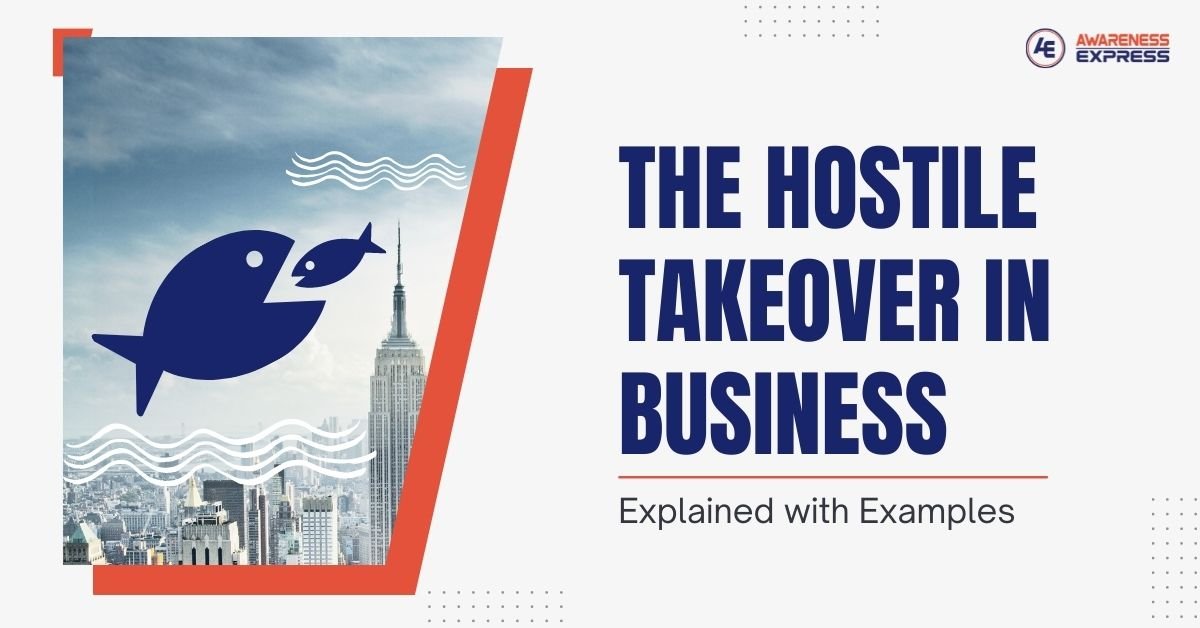The business world is full of anomalous things. It’s not unusual to see situations where a big fish gobbles the small ones. The small fish run for their life. A hostile takeover is one such situation.
What is a Hostile Takeover in Business?
A hostile takeover means that a company gets acquired by another corporation without the consent of the former’s leadership. The acquired company is known as the target company, and the company that takes over is known as the acquirer.
A hostile takeover is unlike a traditional acquisition where two companies work through an agreement. You might wonder, what is a hostile takeover in business?
In a hostile takeover, a target company’s board of directors sign-off the deal and does not want the sale; the acquiring company directly reaches out to the shareholders. In their takeover attempts, they may tender offers or purchase shares at a premium. With the acquirer purchasing of a large number of shares and controlling interest, a hostile takeover occurs successfully.
Hostile Takeover-Prominent Example
The 1980s saw a rise in the number of hostile takeovers in the US. The entire decade featured so many prominent takeover attempts giving a negative image to American corporations. This also spread to Europe. In 2010 the French biotech company Sanofi-Aventis offered to buy the U.S. biotech company Genzyme, which was declined by Genzyme’s leadership. Sanofi attempted a takeover successfully by directly taking the bid to the shareholders. The company completed the acquisition in 2011.
Friendly Takeover
Unlike a hostile takeover, it is a friendly takeover or a merger. In a merger, the acquiring company and target company agreed to sign off on the deal. In such a merger, an acquiring company won’t give the individual shareholders an acquisition premium. In a friendly takeover, individual shareholders may either get a positive or a negative impact on profit.
In both friendly and hostile takeovers, we get a single merged company.
How Hostile Takeovers Works
An acquirer may attempt a hostile takeover if the target company’s management does not consent to the acquisition bid. The acquiring company can do it with two kinds of strategies:
- Tender offer to purchase shares
- Proxy fight.
Tender Offers to Purchase Shares
When the acquirer or the hostile bidder directly reaches out to shareholders to tender an offer to purchase shares at a premium price, bypassing the target company’s leadership. Though, the shareholder decides to sell or not to sell their stake in a company. The acquirer wants to buy enough shares to control a stake in the target company. Presently, in the US, the Securities and Exchange Commission (SEC) regulates tender offers.
Proxy Fight To Replace Board of Directors
A proxy contest occurs when a hostile acquiring company makes aggressive attempts to replace the management of the target company. They want to get the majority of the board members to agree to the sale.
Proxy fights give acquirers lower chances of success because activists can get shareholders to vote for the company’s management. So, it gets hard to replace board members.
Proxy Fight Example 2008-Microsoft versus Yahoo!

Microsoft wanted to purchase Yahoo! Yahoo!’s board and did not consent to the same. Microsoft launched a proxy contest in an attempt to nominate its directors to Yahoo!’s management. Microsoft’s takeover attempt proved unsuccessful, and it abandoned its bid to acquire Yahoo! a few months later.
Defensive Strategies to Prevent Hostile Takeovers

Naturally, companies would develop strategies to defend against hostile takeovers. Such defensive strategies are known as shareholder rights plans; examples include:
- Poison pills
- Crown jewel defense
- Golden parachutes.
These strategies aim to make a takeover very hard, expensive, or interesting to the potential acquirer or bidder.
One of the commonest defensive strategies is the flip-in poison pill. This is how it works. As a hostile bidder gains a certain (fixed) percentage of shares, the flip-in poison pills get automatically triggered. Now, the triggered poison pill gives its shareholders the right to purchase more shares at a lowered price. But, the discount on the lower price to purchase shares is not available to the bidder.
As the target company floods the market with shares, it blunts down the impact of bidders’ attempt to take over the company.
However, poison pills can prove disadvantageous for individual investors. because the introduction of a large number of shares in the market dilutes the ownership of shareholders. This means investors need to spend more to maintain their stake in the company.
Another is crown jewel defense. In this strategy, the target company sells or spins off its most attractive assets to a friendly third party. Consequently, the hustle bidder has no attraction to acquire the target company.
What It Means for Individual Investors
Usually, Individual investors have to bear a negative impact due to a hostile takeover. However, the precise harm would be based on various factors. There are a few things to do. Hostile takeovers may not necessarily bring loss to the shareholders. Rather, shareholders may incur dividends or profit as share prices increase for both target and acquiring companies. If the hostile bidder buys shares at a premium price, you can get a profit by selling your shares.
But, if individual investors decide to hold on to your shares, you may not be able to guess about the long-term effects on share prices. This is more or less related to the company’s performance.
Conclusion
For those considering what is a hostile takeover in business, here are a few takeaways. A hostile takeover refers to acquiring a company or corporate bidder which tries to take over a target company whose management is not willing for the same.
An acquiring company attempts to take over with a tender offer to purchase shares at a higher price or proxy fight to replace existing management with their people.
If a company thinks it is being undervalued in an offer by the acquirer and resists, the acquirer may respond with a hostile takeover. In other cases, if activist shareholders want changes in the company, a hostile takeover may take place. Target companies rely on poison pills or golden parachutes, which are defense strategies to prevent hostile takeovers.









